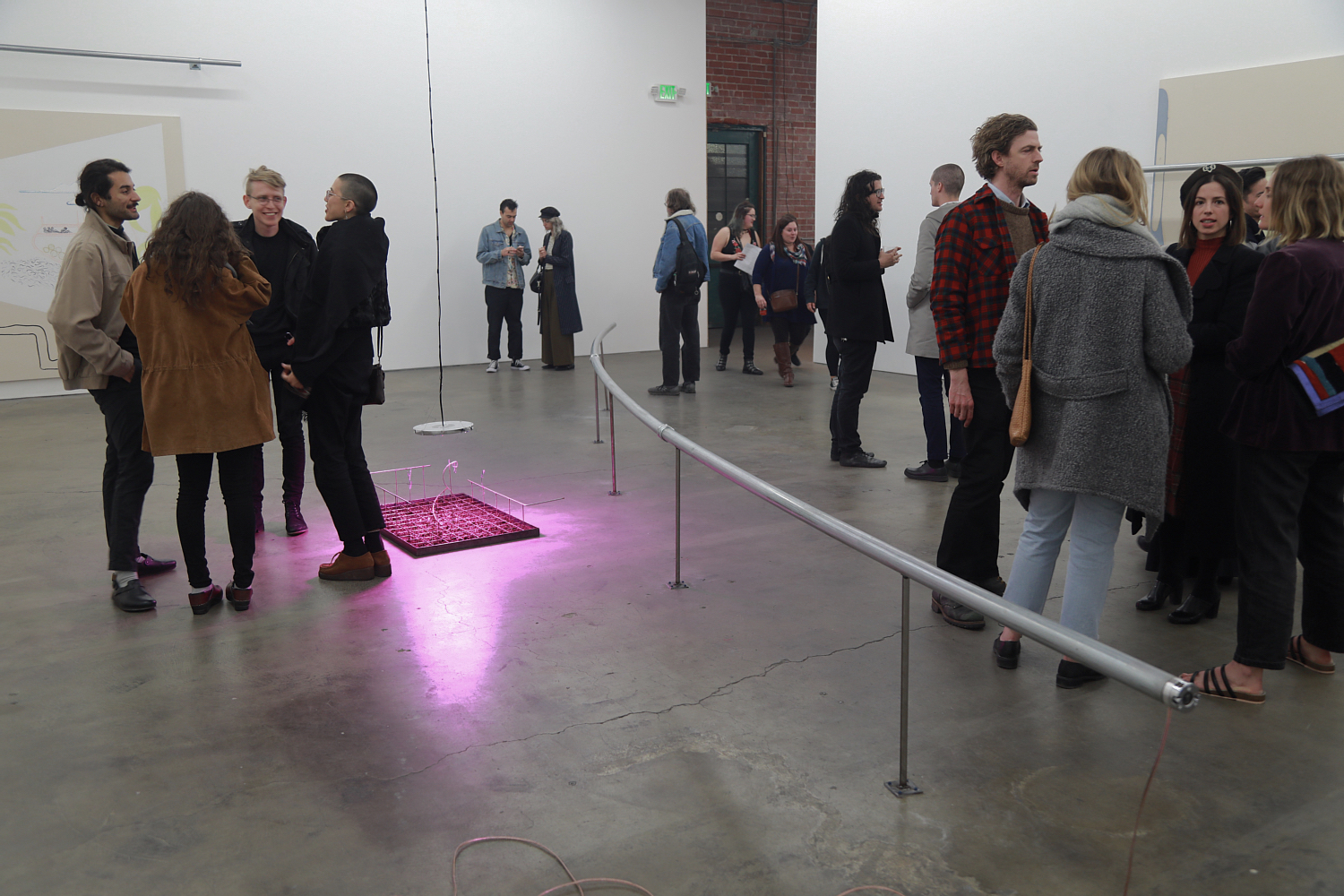Ghebaly Gallery is pleased to present Florian Meisenberg, The Taste of Metal in Water, the New York-based artist’s first exhibition with the gallery. The show, a body of new paintings in a sculptural sound installation, unspools like a vivid session of lucid dreaming. Metal pipes slice the space into particular trajectories.
The spasming of my diaphragm opened some kind of rift, I think of the space-time kind. I entered a short looping recursion. Time ended and began again with each hic-cup. The spasm came from below my consciousness—very small—and from far above it—very large. It’s happened to me before: listening to my John Adams LP, the one with the deep scratch that loops Harmonium ad infinitum. Or, like my many cycles of reincarnation.
Why must we leave dreams to the psychoanalysts? In our dreams we build worlds freed from the enclosures of reason. Why should we be reasonable in our aspirations for political justice? Let us structure our daylight around the social possibilities disclosed in the night.
This spasming has become the core of the exhibition, the heartbeat for experiencing and breathing. Hiccup…hiccup…hiccup: a mantra for refining the mind’s focus. It will be the LSD for the show. The mind expander.
The pipes, extensions of the guts of the building, carry neither electricity nor water, but instead small and resonant hiccups that spread throughout the space. In the middle of the room sits a miniature scale model of the gallery. Following the left-turn logic of dreams, a drip, drip, drip of liquid falls from the rafters, watering the model and the growing grasses inside.
A series of new paintings operate collectively as a stream of memories. The paintings, populated with hieroglyphic signifiers, show a spectrum of techniques, from airbrushed hazes to straight-from-the-tube line drawings. Unprimed canvas draws excess linseed oil straight out of the paint, leaving sweaty halos around certain forms. In some works, the grime of downtown Los Angeles becomes a medium in its own right, leaving indexical impressions like an archaeologist’s rubbing.
For Meisenberg, the canvas can be seen as a membrane to be transgressed, and therefore operates as a model for the crossing of all kinds of permeable boundaries. Each painting is like a film still, open to analysis yet always referring to a larger sequence of images.
Today I figured out how to force myself to get a hiccup. There is an urban legend that pork rinds can induce hiccupping. My very own pork rind is ginger, cayenne and lime.
The paintings contemplate the experience of viewership. The figures that populate the works turn the world around them into screens, floating images that they observe dispassionately. Ghostly elephant forms intrude from the edges with huge empty eyes and unlimited memories. An explorer peers through a telescope at a distant land. These observers demand that the viewer take account of their viewership, own it, engage with their passivity or activeness in relationship to the images that surround them.
One hypothesis holds that the forceful inhalation of the hiccup serves as an early breathing mechanism preparing a fetus for breath after birth.
Florian Meisenberg (b. 1980, Berlin) lives and works in New York. He trained as a media designer before studying painting at the Kunstakademie Düsseldorf with Peter Doig, graduating in 2010. Recent select solo exhibitions include Simone Subal Gallery, New York; Wentrup Gallery, Berlin; Kölnischer Kunstverein, Cologne; Mendes Wood DM, São Paulo; Kasseler Kunstverein, Kassel. Recent select group exhibitions include Institute of Contemporary Art, Philadelphia; Kiasma National Gallery, Helsinki; Signal, Brooklyn, Schirn Kunsthalle, Frankfurt; Queens Museum of Art, New York; and KW Kunstwerke, Berlin. His work is held in prominent public and private collections internationally, including the Hammer Museum, Los Angeles; Kiasma National Gallery, Helsinki; Boros Collection, Berlin; Julia Stoschek Collection, Düsseldorf; Becker Collection, Cologne; Wilh.-Otto-Nachfolg.-Smlg., Cologne; Sammlung Köstlin, Berlin; Sammlung Dietz, Stuttgart; Drake Collection, Amsterdam; Vanhaerents Art Collection, Belgium; Philara Collection, Düsseldorf; Pizzuti Collection, Columbus; and the Zabludowicz Collection, London.

